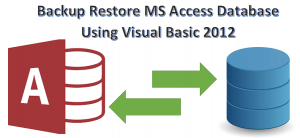Backup Restore MS Access Database Using Visual Basic 2012
A simple way to create a Backup Restore MS Access Database Using Visual Basic 2012, I have a sample code snippet to enable the backup and restore thing.
In this course, I assumed that you have already a background in using Visual Basic.Net or VB 2008 up to a higher version.
Backup and restoration are critical in case you accidentally erase something crucial in the system’s information.
So, in this article, I’ll show you how to use VB.Net to backup and restore an MS Access database, allowing you to easily backup and restore the file.
Simply follow the steps outlined below. Before we begin, place your Microsoft Access database under the project folder’s Debug folder. BackupRestoreAccess\BackupRestoreAccess\bin\Debug
Tutorials Start:
- Microsoft Visual Studio 2012 is now open.
- On the File menu, choose New Project.
- Click OK after selecting Visual Basic, Windows Form Application.
In our form, we’ll need the following controls:
- 2 labels for the labeling of the source and destination file textboxes, as well as 2 labels for the open file and save file dialogues.
- Text boxes for the source and destination files are included in the second text box.
- One command button and one backup button
- Dialogue to save a file
- 1 Dialogue in an Open File
In the same approach, we’ll call our form controls:
- The textbox for username is called txtsource.
- The textbox for Password is called txtdestination.
- The button for Login is called cmdbackup.

Here’s the code for backup:
Try
'call the SavefileDialog box runest
Save_file_Dialog.ShowDialog()
'Set the title
Save_file_Dialog.Title = "Save File"
'Set a specific filter
Save_file_Dialog.Filter = "(*.mdb)|*.accdb"
If Save_file_Dialog.ShowDialog = Windows.Forms.DialogResult.OK Then
'set the destination of a file
textboxDestination.Text = Save_file_Dialog.FileName
Dim portfolioPath As String = My.Application.Info.DirectoryPath
'create a backup by using Filecopy Command to copy the file from location to destination
FileCopy(textboxlocation.Text, textboxDestination.Text)
MsgBox("Database Backup has been Created Successfully!")
'Reload the form
Call Form1_Load(sender, e)
'Clear content of those two textboxes
textboxlocation.Text = Nothing
textboxDestination.Text = "Destination..."
End If
Catch ex As Exception
'catch some error that may occur
MsgBox(ex.Message)
End TryFor Restore code:
Try
'call the SavefileDialog box
Save_file_Dialog .ShowDialog()
'Set the title
Save_file_Dialog .Title = "Save File"
'Set a specific filter
Save_file_Dialog .Filter = "(*.mdb)|*.accdb"
If Save_file_Dialog.ShowDialog = Windows.Forms.DialogResult.OK Then
'set the destination of a file
txtDestination.Text = Save_file_Dialog .FileName
Dim portfolioPath As String = My.Application.Info.DirectoryPath
If MessageBox.Show("Restoring the database will erase any changes you have made since you last backup. Are you sure you want to do this?", "Confirm Delete", MessageBoxButtons.OKCancel, MessageBoxIcon.Question, MessageBoxDefaultButton.Button2) = Windows.Forms.DialogResult.OK Then
'Restore the database from a backup copy.
FileCopy(textboxlocation.Text, textboxDestination.Text)
MsgBox("Database Restoration Successful")
End If
'Reload the form
Call Form1_Load(sender, e)
textboxlocation.Text = Nothing
textboxDestination.Text = "Destination..."
End If
Catch ex As Exception
'catch some error that may occur
MsgBox(ex.Message)
End TryRelated articles:
- Saving records in MS Access database using VB.net
- Deleting records in the MS Access database using VB.net
You can try this source code if it really works. If you have any questions or suggestion about Backup Restore MS Access Database Using Visual Basic 2012. Please drop your message on our contact page.
To show your support. please share this post with your friends and click like our page. thanks

